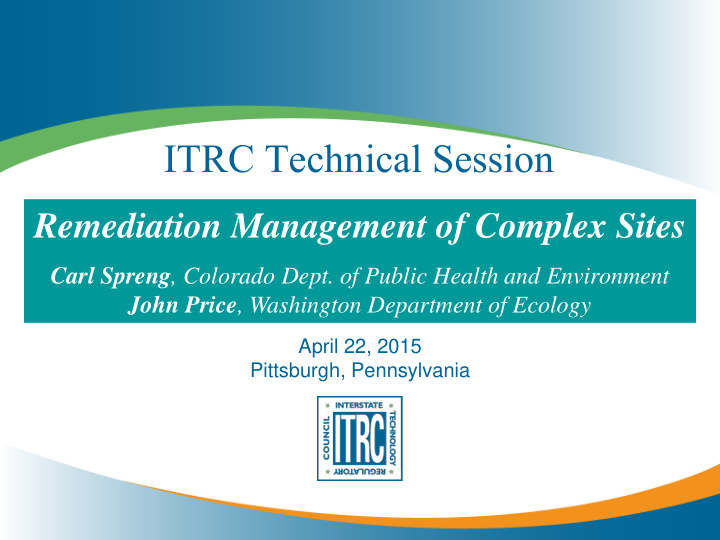



ITRC Technical Session Remediation Management of Complex Sites Carl Spreng , Colorado Dept. of Public Health and Environment John Price , Washington Department of Ecology April 22, 2015 Pittsburgh, Pennsylvania
Remediation Management of Complex Sites PROBLEM Despite nearly 40 years of remediation efforts, remediation of groundwater to a condition allowing for unlimited use/unrestricted exposure remains a significant challenge An NRC committee recently examined cleanup efforts nationally and reported that at least 126,000 sites across the country have residual contamination at levels inhibiting site closure with an estimated “cost to complete” of $127 billion. Of these sites, roughly 10% are “complex” Conventional remedies and approaches are difficult to apply successfully at complex sites APPLICABLE REGULATORY PROGRAMS State and federal Superfund, RCRA, state cleanup programs including Voluntary Cleanup Programs, DoD, DOE, and NRC. DRAFT TEAM SOLUTIONS Technical and regulatory guidance document which synthesizes existing guidance, compiles case studies and provides a consensus on strategies to meet cleanup goals OPEN ISSUES Definition of a “Complex Site” Technical Impracticability (TI) waivers: under-used or over-used? How much should be done up- front when UU/UE closure “clearly” isn’t possible?
Problem Statement Despite nearly 40 years of remediation efforts in the United States and other industrialized countries, remediation of groundwater to a condition allowing for unlimited use and unrestricted exposure remains a significant challenge. Conventional remedies and approaches are difficult to apply successfully at complex sites from a hydrogeological and contaminant perspective.
Problem Statement (Continued) A 2013 National Research Council committee examined cleanup efforts nationally and reported that at least 126,000 sites across the country have residual contamination at levels inhibiting site closure with an estimated “cost to complete” of $127 billion. Of these sites, roughly 10% are deemed “complex.”
Applicable Regulatory Programs State and federal Superfund RCRA State cleanup programs (including Voluntary Cleanup Program) DoD DOE NRC
Project Description/Solution Technical and Regulatory Guidance • Synthesizes existing guidance • Compiles case studies • Provides a consensus on cleanup strategies Existing tools and strategies will be adapted to: • Focus on technical justification • Focus on remedy implementation approaches • Support aspects of remedial management specific to complex sites Remedy selection Remedy implementation Long-term performance evaluation
Open Issues / Questions for Group Does this guidance need to specifically define what a “Complex Site” is? Are Technical Impracticability (TI) waivers under-used or over-used? How much should be done up-front when UU/UE closure clearly isn’t possible? How many technologies should be tried (and fail)?
Recommend
More recommend